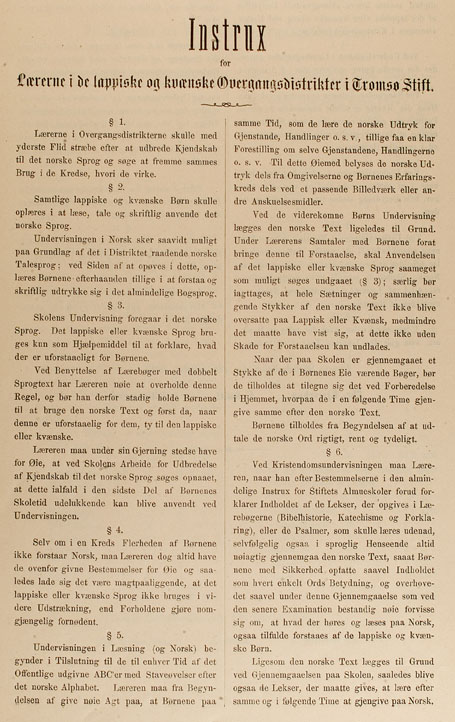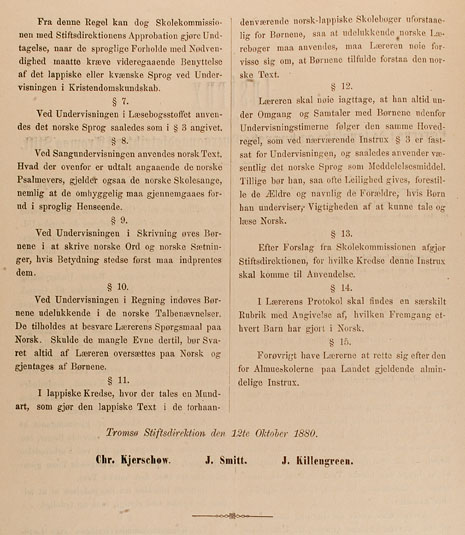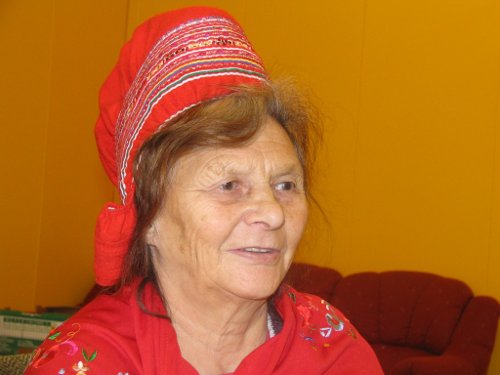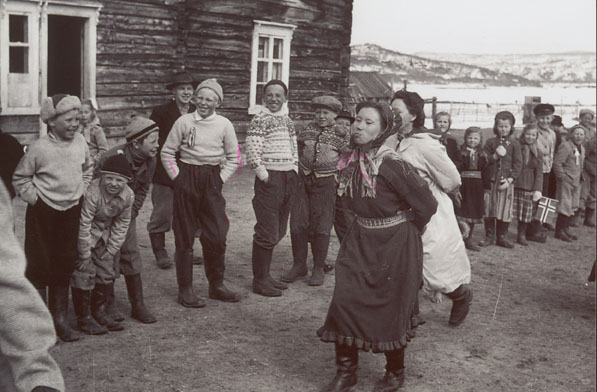 Sámegillii
Sámegillii  På norsk
På norsk
Articles about Sami school history
Part 29 - printed in Ávvir xx.03.2013
Do you know Sami school history?Here we present a series of articles printed in Sami language in the newspapers Min Áigi and Ávvir from 2007 to 2013. The basis of the articles are stories which have been collected through the project “Sami school history”. There are edited 6 books with stories and articles from school life in the Norwegian part of Sápmi. In these articles there are many quotes from the books, and we refer to the articles the quotes are taken from, to make it possible to read the entire stories there.The chief editor of Sami school history, Svein Lund, is editing this series of articles. In addition Elfrid Boine, Siri Broch Johansen and Siv Rasmussen are part of the editorial staff.
|
Who is right? Or does a clear answer exist at all? In the series of books Sami school history there are many stories which can give a pointer. Extracts from five of them have been recounted in the article On Sami teachers, which was printed in Ávvir 23.05.2009 (http://skuvla.info/minaigi11-n.htm). We will supplement them here with some more stories to see if it all together makes a picture of the relation between the regulations and the practices for the use of language in the school. At first we will have a look at the regulations and practices for the teachers.
According to the first instruction, the pupils should learn to read, talk and write Norwegian, but at the same time they should learn to read Sami. Later the aim to learn Sami was removed, and Sami was reduced to an auxillary language which was only to be used if it was "inevitably required". How to interpret this then became a matter as to which opinions differed.
 | 1880 instruksa skuvlla giellageavaheami birra mielddisbuvttii ahte dáruiduhttin šattai vel gárraset go ovdal. Unna rievdadusaiguin 1898:s dát lei skuvlla politihka sullii 1960 rádjái. |  |
What the pupils experienced was not always in accordance with the valid instruction. A great part of the teachers teaching Sami speaking pupils did not know enough Sami to be able to use it as auxillary language. At the same time many teachers could have used the auxillary language, but they did not do so, as they either themselves were of the opinion that it was better to use solely Norwegian or they had interpreted the orders from their superiors in such a way that they should not make use of anything but Norwegian.
On the other had there were teachers who used the "auxillary language" more than what the instruction opened for, because they meant it was pedagogically necessary. This applied both to Sami teachers, and some Norwegian teachers who had learned Sami. Probably there were also a few Sami teachers who spoke too poor Norwegian to be able to follow the instruction entirely.
Our teacher spoke Sami and Finnish.
He had been taught at school in Lakselv.
When he attended school they had bilingual textbooks.
Sami and Norwegian.
He spoke Sami with us both outside and inside school
but had to teach us to read in Norwegian.
We learnt about numbers.
"Fire" (4) and "fem" (5) the teacher said.
It was difficult to understand the meaning.
The teacher said it meant “njeallje” and “vihtta”.
Then we understood.
(Hans Hansen, pupil in Porsanger from 1923 – SSH1)
– It was a Sami speaking teacher there, Kirsten Porsanger Sara. She normally spoke Norwegian in the lessons. She made a quite clear separation: in the lessons she mainly spoke Norwegian, while she spoke Sami with us in the breaks. If we did not understand what she said in Norwegian, she would explain in Sami.
(Synnøve Solbakken-Härkönen, Karasjok school from 1965 – SSH5)
Several of the pupils hint that their teachers might have used more Sami than what the instruction and the superior scool authorities allowed:
– In the school there was only one teacher who knew Sami, Anders O. Eira, who came from Máze himself. He taught us in religion, which was the only subject in which it was allowed to teach in Sami. We also had Bibel-history books in Sami. I think Anders spoke more Sami in the school than what he was supposed to do according to the rules in force at the time.
(Johan Tore Eira, pupil in Masi from 1952 – SSH3)
– In the fifth grade they had a Sami speaking teacher again, his name was Kristian Nymo and he came from the village. Father tells that this teacher taught in Sami, although it was not allowed at all. Probably the teacher understood that the children were not able to learn much in the foreign language. He taught and explained everything in Sami.
(Samuel John Anti, pupil in Karasjok from 1958. Told to Ann-Silje Guttorm – SSH6)
Similar stories are told by Jon Ole Andersen from Polmak school (SSH1) and Karl M. Paulsen from Musken in Tysfjord (SSH2), both recounted in the article mentioned above.
But there are also many who tells that Sami speaking teachers only made use of Norwegian:
– On the conterary teacher Soleng and teacher Nordnes, probably both spoke Sami, but they only spoke Norwegian in school.
(Nils Sneberg, pupil in Kåfjord from 1925 – SSH2)
– I remember three teachers: Alfred Larsen, Anders Bongo and Edel Hætta Eriksen. Sami was the mother tongue for all of them, but it was strictly prohibited to speak Sami. Therefore they all taught in Norwegian. Bongo spoke Sami only when he got angry. When we did not understand, they hit us with the pointer in the head, and of course it happened often that we did not understand.
(Inger Marie Sokki Hætta, pupil in Guovdageaidnu from 1938 – SSH5)
 | Inger Marie Sokki Hætta muitala su oahpaheddjiid birra: "Buohkain lei sámegiella eatnigiellan, muhto lei áibbas gielddus sámegiela hupmat. Danin buohkat oahpahedje dárogillii." (Photo: Svein Lund) |
– The teacher was Jan K. Lund. He had supposedly learned Sami, but he had made it his principal to only use Norwegian at school.
(Ellen Turi Guttormsen, pupil in Masi from 1940 – SSH3)
– The teacher was Norwegian speaking, Madsen. I did not understand anything. He was supposed to speak Sami, but he was not allowed to speak Sami in the school. That's how the politic was back then, Sami language was supposed to be eradicated.
(Nils A. Skum, pupil in Guovdageaidnu from 1941 – SSH5)
There I learnt almost nothing as everything was in Norwegian. Well, some of the teachers spoke Sámi but what good was that when teaching in Sámi was prohibited.
(Sara Tornensis Bongo, pupil in Guovdageaidnu from 1946 – SSH1)
– A few teachers were Sami speaking, but they did not use Sami in the school. Therefore it was not a great difference between the Sami speaking and the Norwegian speaking teachers.
(Klemet I. Hætta, pupil in Guovdageaidnu from 1962 – SSH5)
This is confirmed from some Sami speaking teachers who tells that they were ordered to use solely Norwegian, for instance Edel Hætta Eriksen, teacher in Guovdageaidnu from 1940 (SSH1) and Ellen Turi Guttormsen, teacher in Máze from 1959 (SSH3)
– As everybody probably will understand, I did not know a single word of Lappish (Sami) when I came to Karlebotn. I tried to learn a little bit, because I am very interested in languages. ... But nevertheless it went pathetically slow for me, and as of today I still do not speak any Lappish. The reason the results were so poor, is that I was not supposed to say anything in Lappish in the school. I was supposed to speak Norwegian, speak slow and clear and try to make myself understood by that. Therefore it was not necessary, and I believe not wanted either, that I learned anything of the children's language.
(Leif Sletsjøe, teacher in Nesseby 1946/47 – SSH4)
 | Miessemánu 17.beaivvi ávvudemiide gulai buđetviehkan. Buolbmát skuvllas 1950-logu álggus. Deike háliidedje skuvlaeiseválddit oahpaheaddjit geat eai máhttán sámegiela (Photo: Ivar Skotte) |
– We were one teacher short just before the school started. The school council made the superintendent of schools aware that there was a young person in the village who spoke Sami and who would like to be a teacher in the school. He was a student with a couple of years experience as a teacher. But the superintendent of schools turned down the proposition. And a young female student from Oslo arrived a few days later. She had just finished her upper secondary school exam in the spring, and didn't speak any Sami of course. This shows how the school politics in the Sami area was in those days. All teaching should be held in Norwegian.
(Ivar Skotte, teacher in Polmak from 1951 – SSH1)
It varied how strict the practice that the teachers had to teach in Norwegian was applied. In the next article we will have a look at how the norwegianizing steered the pupils' use of language.
28.09.2007 Why Sami school history?
05.10.2007 Boundless ignorance
12.10.2007 Southerner-teachers encounter the Sami language
19.10.2007 The start of Sami beginner instruction
26.10.2007 The start of education in reindeer-herding
02.11.2007 From Sami to Norwegian vocational training
16.11.2007 Struggle for Sami gymnasium
28.11.2007 School experiences of Norwegian speaking Samis
14.12.2007 Resistence against Sami language and culture
25.01.2008 A strange world
23.05.2009 On Sami teachers
30.05.2009 Life in boarding school
06.06.2009 Sami pupils were bullied
13.06.2009 Sami content in the teaching
20.06.2009 Pupil as interpreter
04.07.2009 How the children quit speaking Sami
10.09.2010 God does not understand Sami
08.10.2010 The point of view of the Norwegianizers
13.10.2010 Men of the church defending the Sami language
02.12.2010 Sami teachers in old times
09.12.2010 Boarding school life in old times
18.12.2010 Sami pupils in special schools
14.01.2012 The parents' struggle for Sami education
21.01.2012 Reluctance and absence
28.01.2012 The school during the war
04.02.2012 Reconstruction and barrack schools
11.02.2012 Curriculums - for Norwegianization and for Sami school
18.02.2012 The great struggle of the curriculum
11.05.2013 Sami language forbidden? – 1
xx.05.2013 Sami language forbidden? – 2
xx.05.2013 Folk high school for norwegianization
xx.06.2013 Folk high school against norwegianization?
xx.06.2013 Skolt Sami school history – does it exist?
xx.06.2013 Duodji education – in and outside of school
xx.06.2013 Sami in the cities
xx.07.2013 Sami language in teacher education
Sami school history 1
Sami school history 2
Sami school history 3
Sami school history 4
Sami school history 5
Sami school history 6
Sami school history - main page